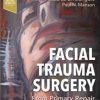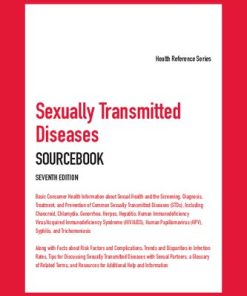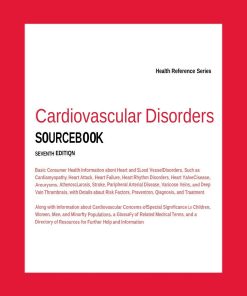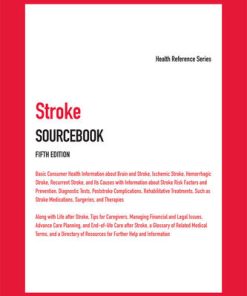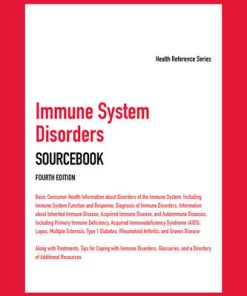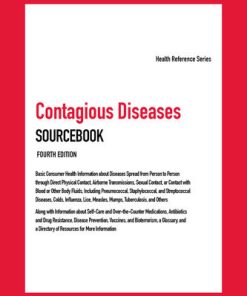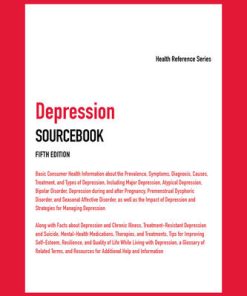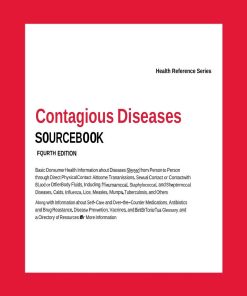Pregnancy and Birth Sourcebook 4th Edition by Angela Williams 0780816435 9780780816435
$50.00 Original price was: $50.00.$25.00Current price is: $25.00.
Pregnancy and Birth Sourcebook 4th Edition by Angela L. Williams – Ebook PDF Instant Download/DeliveryISBN: 0780816435, 9780780816435
Full download Pregnancy and Birth Sourcebook 4th Edition after payment.

Product details:
ISBN-10 : 0780816435
ISBN-13 : 9780780816435
Author: Angela L. Williams
Offers basic consumer health information about physical, sensory, cognitive, and learning disabilities, along with facts about assistive devices, technologies, and related services to promote independence, and guidance for families on education and employment options, legal, and financial concerns.
Pregnancy and Birth Sourcebook 4th Table of contents:
Part One—Introduction to Disabilities
Chapter 1—What Is a Disability?
Chapter 2—Statistics on People with Disabilities in the United States
Chapter 3—Common Barriers to Participation Experienced by People with Disabilities
Chapter 4—Myths and Facts about People with Disabilities
Chapter 5—Women with Disabilities
Chapter 6—Aging and Disabilities
Chapter 7—Communicating with and about People with Disabilities
Chapter 8—A Guide for Caregivers of People with Disabilities
Chapter 9—Abuse and People with Disabilities
Section 9.1—Childhood Bullying
Section 9.2—Abuse of Children with Intellectual Disabilities
Section 9.3—Violence against Women with Disabilities
Part Two—Types of Disabilities
Chapter 10—Overview of Birth Defects
Chapter 11—Cerebral Palsy
Chapter 12—Cleft Lip and Palate
Chapter 13—Cystic Fibrosis
Chapter 14—Inherited Disorders of Metabolism
Chapter 15—Muscular Dystrophy
Chapter 16—Spina Bifida
Chapter 17—Sensory Disabilities
Section 17.1—Hearing Loss
Section 17.2—Hearing Loss in Children
Section 17.3—Vision Loss
Section 17.4—Deaf-Blindness
Chapter 18—Speech Disorders
Section 18.1—Aphasia
Section 18.2—Apraxia
Chapter 19—Intellectual and Cognitive Disabilities
Section 19.1—Down Syndrome
Section 19.2—Fetal Alcohol Spectrum Disorders
Section 19.3—Shaken Baby Syndrome
Chapter 20—Learning Disabilities
Section 20.1—Learning Disabilities: Overview
Section 20.2—Dyscalculia
Section 20.3—Dyslexia
Section 20.4—Dysgraphia
Section 20.5—Dyspraxia
Chapter 21—Autism Spectrum Disorders
Chapter 22—Attention Deficit Hyperactivity Disorder
Chapter 23—Psychiatric Disability and Mental Disorders
Chapter 24—Degenerative Diseases That Cause Disability
Section 24.1—Alzheimer Disease
Section 24.2—Amyotrophic Lateral Sclerosis
Section 24.3—Arthritis
Section 24.4—Multiple Sclerosis
Section 24.5—Parkinson Disease
Chapter 25—Disability Caused by Injury and Trauma
Section 25.1—Amputation and Limb Loss
Section 25.2—Back Pain
Section 25.3—Spinal Cord Injury: Understanding Paralysis, Paraplegia, and Quadriplegia
Section 25.4—Traumatic Brain Injury
Part Three—Technologies and Services That Help People with Disabilities and Their Families
Chapter 26—What Is Assistive Technology?
Chapter 27—Rehabilitative and Assistive Technology
Chapter 28—Mobility Aids
Section 28.1—Wheelchairs and Other Power-Driven Mobility Devices
Section 28.2—Tongue-Driven Wheelchairs
Chapter 29—Home Use Devices and Modifications
Section 29.1—What Are Home Use Medical Devices?
Section 29.2—Adapting Your Living Space to Accommodate Your Disability
Chapter 30—Devices for Improving Communication and Hearing
Section 30.1—Captions for Deaf and Hard-of-Hearing Viewers
Section 30.2—Cochlear Implants
Section 30.3—Hearing Aids
Section 30.4—Other Hearing Assistive Technology
Chapter 31—Therapy and Services to Aid Communication
Section 31.1—Child Speech-Language Therapy
Section 31.2—Telecommunications Relay Services
Chapter 32—Low Vision Devices and Services
Section 32.1—Living with Low Vision
Section 32.2—Argus Retinal Prosthesis
Section 32.3—Implantable Corneal Device to Correct Near Vision
Section 32.4—What Is Braille?
Section 32.5—Web-Braille
Section 32.6—New Technologies for People with Visual Impairment
Chapter 33—How Therapists Can Assist People with Disabilities
Section 33.1—Occupational Therapists
Section 33.2—Physiatrists and Physical Therapists
Chapter 34—Art and Recreational Therapy
Chapter 35—Service Animals and People with Disabilities
Chapter 36—Finding Accessible Transportation
Section 36.1—Adapting Motor Vehicles for People with Disabilities
Section 36.2—Assistance and Accommodation for Air Travel
Chapter 37—Family Support Services
Section 37.1—Understanding Respite and Hospice Care
Section 37.2—Adult Day Care
Part Four—Staying Healthy with a Disability
Chapter 38—Nutrition and Weight Management Issues for People with Disabilities
Section 38.1—Nutrition and Disability
Section 38.2—Nutrition for Swallowing Difficulties
Section 38.3—Overweight and Obesity among People with Disabilities
Chapter 39—Physical Activity for People with Disabilities
Section 39.1—Exercise Guidelines
Section 39.2—Yoga for People with Disabilities
Chapter 40—Personal Hygiene for People with Disabilities
Section 40.1—Dental Care
Section 40.2—How to Bathe Someone with a Disability
Chapter 41—Bowel and Bladder Problems Associated with Disability
Chapter 42—Pressure Sores: What They Are and How to Prevent Them
Chapter 43—Managing Pain
Chapter 44—Coping with Anxiety Disorders and Depression
Chapter 45—Health Insurance Concerns
Section 45.1—Health Insurance for People with Disabilities
Section 45.2—Medicaid and Children’s Health Insurance Program
Section 45.3—Medicaid and Adults with Disabilities
Chapter 46—Is It a Medical Emergency?
Chapter 47—Rehabilitation: Options for People with Disabilities
Chapter 48—Choosing a Long-Term Care Setting
Part Five—Special Education for Children with Disabilities
Chapter 49—Laws about Educating Children with Disabilities
Section 49.1—Individuals with Disabilities Education Act
Section 49.2—Every Student Succeeds Act
Section 49.3—Section 504 of the Rehabilitation Act
Chapter 50—Evaluating Children for Disability
Chapter 51—Early Intervention Services
Chapter 52—Individualized Education Programs
Chapter 53—Supports, Modifications, and Accommodations for Students
Chapter 54—Students with Disabilities Preparing for Postsecondary Education
Chapter 55—Transitioning Students with Disabilities to Higher Education and Adulthood
Part Six—Legal, Employment, and Financial Concerns for People with Disabilities
Chapter 56—A Guide to Disability Rights Laws
Chapter 57—Questions and Answers about the Americans with Disabilities Act
Chapter 58—Housing and Safety Issues for People with Disabilities
Section 58.1—Centers for Independent Living for Disabled People
Section 58.2—Disability Rights in Housing
Section 58.3—Understanding the Fair Housing Amendments Act
Section 58.4—Housing Rights for People with Disabilities
Section 58.5—Fire Safety for People with Disabilities and Their Caregivers
Section 58.6—Disaster Preparedness for People with Disabilities and Special Needs
Chapter 59—Employees with Disabilities
Section 59.1—Why Work Matters to People with Disabilities
Section 59.2—In the Workplace: Reasonable Accommodations for Employees with Disabilities
Section 59.3—Job Accommodation Situations and Solutions
Section 59.4—Accommodating Mental Illness in the Workplace
Chapter 60—Scholarships and Financial Aid Available to Students with Disabilities
Section 60.1—Finding and Applying for Scholarships
Section 60.2—Scholarships for Students with Intellectual Disabilities
Chapter 61—Social Security Disability Benefits
Chapter 62—Amputation and Social Security Benefits
Chapter 63—Tax Benefits and Credits for People with Disabilities
Chapter 64—Guardianship for People with Disability
Chapter 65—Advance Directives and Advance Care Planning for People with Physical and Intellectual
Part Seven—Additional Help and Information
Chapter 66—Glossary of Terms Related to Disabilities
Chapter 67—Directory of Organizations That Help People with Disabilities
Chapter 68—Directory of Organizations for Athletes with Disabilities
Chapter 69—How Can I Get Help Finding and Paying for Assistive Technology?
People also search for Pregnancy and Birth Sourcebook 4th:
pregnancy birth and beyond
pregnancy and birth chart
conception pregnancy and birth short writing
pregnancy childbirth and the newborn pdf
pregnancy childbirth and the newborn the complete guide pdf
Tags: Pregnancy, Birth Sourcebook, Angela Williams, physical, sensory, cognitive, learning disabilities
You may also like…
Medicine - Infectious diseases
Sexually Transmitted Diseases Sourcebook 7th Edition Angela L. Williams
Medicine - Cardiology
Education Studies & Teaching - School Education & Teaching
Learning Disabilities Sourcebook 6th Edition Angela L. Williams
Relationships & Lifestyle - Health - Diseases & Disorders
Medicine - Immunology
Uncategorized
Relationships & Lifestyle - Diet & Nutrition
Uncategorized
Contagious Diseases Sourcebook 1st edition by Angela Williams 0780816787 9780780816787


